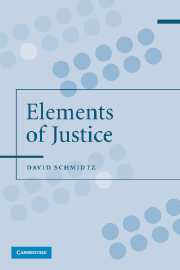Book contents
- Frontmatter
- Contents
- Acknowledgments
- PART 1 WHAT IS JUSTICE?
- 1 The Neighborhood of Justice
- 2 The Basic Concept
- 3 A Variety of Contestants
- 4 Contextual Functionalism
- 5 What Is Theory?
- PART 2 HOW TO DESERVE
- PART 3 HOW TO RECIPROCATE
- PART 4 EQUAL RESPECT AND EQUAL SHARES
- PART 5 MEDITATIONS ON NEED
- PART 6 THE RIGHT TO DISTRIBUTE
- References
- Index
4 - Contextual Functionalism
Published online by Cambridge University Press: 05 June 2012
- Frontmatter
- Contents
- Acknowledgments
- PART 1 WHAT IS JUSTICE?
- 1 The Neighborhood of Justice
- 2 The Basic Concept
- 3 A Variety of Contestants
- 4 Contextual Functionalism
- 5 What Is Theory?
- PART 2 HOW TO DESERVE
- PART 3 HOW TO RECIPROCATE
- PART 4 EQUAL RESPECT AND EQUAL SHARES
- PART 5 MEDITATIONS ON NEED
- PART 6 THE RIGHT TO DISTRIBUTE
- References
- Index
Summary
Thesis: The realms of justice, governed by different principles, are distinct, but sometimes clash.
A PLURALIST THEORY
I am wary of labels, but we can describe my theory as contextual functionalism. The theory is pluralist, insofar as none of its four primary elements is an overarching standard to which the others reduce. The theory is contextual insofar as respective elements rule only over limited ranges. Ranges are topics that are mutually exclusive more or less, jointly spanning the subject of justice more or less. Ranges are like tectonic plates insofar as their edges shift as our conception evolves. (Civil rights movements aim to extend the range of equality before the law.) The shifting can leave gaps in some places, and overlaps elsewhere. Thus, range-bound elements may leave some questions unanswered, and answer some questions in clashing ways. Moreover, places where principles clash are chaotic, insofar as “butterfly” effects – variations in detail – lead to different conclusions. So, is it unjust for me to hire my cousin? The details matter.
The theory is functionalist in saying we can try to resolve uncertainty over what to believe by asking what justice is for. There are considerations beyond justice. Some of them matter, regardless of whether they matter within the arena of justice. When considerations internal to the concept (for examples, analyzing the word ‘due’) do not settle which rival conception we should believe, we can ask what matters outside the arena, without prejudice to ideas that matter within.
- Type
- Chapter
- Information
- The Elements of Justice , pp. 17 - 20Publisher: Cambridge University PressPrint publication year: 2006

